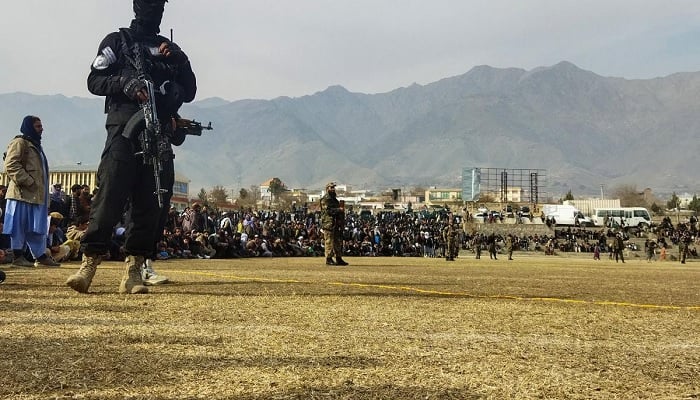
- After repeated case reviews, all persons were hanged to kill.
- Two people were shot dead by a male relative of the victims in Qala.
- The third person was hanged in Zaranj and the fourth in Farah city.
Four people were publicly executed in Afghanistan on Friday, the Supreme Court said, “The highest sentence is being given the highest sentence in one day after the Taliban return to power.”
According to one, the executions at sports stadiums in three provinces killed the total number of men from 2021 to 10 to 10 in public. AFP tally.
From 1996 to 2001, public execution was common during the Taliban’s first principle, mostly being publicly performed at sports stadiums.
The witnesses told the ANA that two men were shot dead six or seven times by a male relative of the victims in front of spectators in Qala-Nao, the center of Buddhist province. AFP Journalists in the city.
“They were designed to sit and turn our backs,” said Mohammad Iqbal Rahimiyar, 48, said Mohammad Iqbal Rahimiyar, 48 -year -old spectator. AFP.
The Supreme Court said in a statement that other men were sentenced to “retaliation” for shooting other men after being “very clear and repeated”.
It states that the families of the victims rejected the opportunity to offer a general amnesty to the men.
“It would have been better if the families of the victims had forgiven men, otherwise it was God’s command, and it should be implemented,” a 35 -year -old man who told Zabilah Allah had given his name. AFP Out of the stadium
On Thursday, Afghans were invited to “attend the event” in widespread government notices shared.
The Supreme Court said that a third person was hanged in the Zaranj, Nimroz Province, and the fourth was in Farah city in the western province of the same name.
“It is good that the Islamic Emirates show their politics and power. I am very happy with it,” said another 30 -year -old spectator, citing the official name of the Taliban government.
Amnesty International called on Taliban officials to stop public executions, which it called “overall competition for human dignity”.
Eye for the eye
The previous execution was in November 2024, when a convicted killer shot three times in the chest in front of thousands of spectators, including thousands of fans, including advanced Taliban officials, who were in a stadium in the capital of East Paktia.
Physical punishment – mainly whipped – has been common under Taliban authorities and is employed for crimes, including theft, adultery and alcohol.
However, all the execution orders have been signed by the Taliban’s controversial Supreme Leader Halbatullah Akhundzada, who lives in the heart of the Kandahar movement.
Akhandzada ordered the judges in 2022 to fully implement all aspects of the Taliban government’s translation of Islamic law-including the punishment for “eye-for-eye”, which allowed the death penalty to avenge the murder.
Peace and order is the focus of the Taliban, which came out of the chaos of civil war since the withdrawal of Soviet forces from Afghanistan in 1989.
In a very notorious picture of his first principle, the execution of a woman wearing a female burqa at Kabul Stadium in 1999. She was accused of killing her husband.
Amnesty, such as UN and rights groups, has condemned the use of Taliban government’s physical punishment and death sentence.
The non -governmental organization said in its annual report on the death penalty published in April that Amnesty also included Afghanistan in countries where “death sentence was sentenced, which was imposed after a proceeding on the standard of an international fair trial”.
Amnesty said thousands of people were not included in the 1,518 executions worldwide in 2024, who are believed to have been hanged in China.


